Art World
7 Ways of Looking at the Memento Mori, Art History’s Spookiest—and Most Misunderstood—Genre
From skull emojis to Damien Hirst, the symbolism is everywhere. We're here to help you navigate its art historical roots.

From skull emojis to Damien Hirst, the symbolism is everywhere. We're here to help you navigate its art historical roots.

Growing up around the Museum of Fine Arts, Boston, where his father worked, art historian Stephen Perkinson always knew to check what was installed near the water fountain. While curators felt the need to show the museum’s most famous works in the main galleries, side galleries like that one, they told him, were where they got to play.
In graduate school, Perkinson began to notice an intriguing kind of art—memento mori objects—in those secluded spaces. “They tended to be displayed in groups, like taxonomies,” says Perkinson, now an associate professor of art history at Maine’s Bowdoin College. These peripheral displays sparked a career-long interest in the genre, which is now the subject of his latest exhibition, “The Ivory Mirror: The Art of Mortality in Renaissance Europe” at Bowdoin’s Museum of Art (through November 26).
Memento mori, Latin for “Remember that you must die,” is a genre that draws upon the melancholic character of the biblical book of Ecclesiastes. Eat, drink, and be merry if you must, the objects suggest, because death is right around the corner. Memento mori paintings, drawings, and sculptures can range from blunt depictions of skulls, decaying food, and broken objects to subtler examples whose symbolism is easy to miss. Artists as varied as Albrecht Dürer, Rembrandt, and Damien Hirst have worked in the genre. These objects had their heyday in the 16th century, when they found an eager audience among wealthy European collectors.
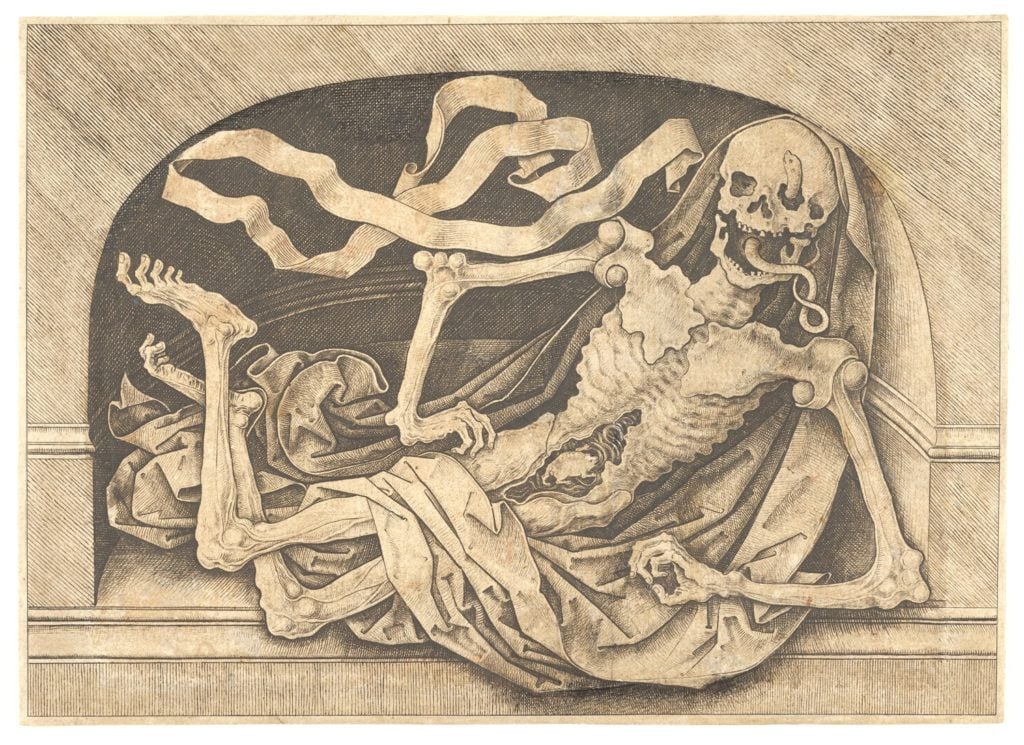
Master IAM of Zwolle,
Memento Mori (late 15th century).
Courtesy of the Metropolitan Museum of Art, New York.
In recent years, fascination with the genre has resurfaced, both within the museum and outside it. Images of death are everywhere, “from the fashions of Alexander McQueen, to mock skeletons on suburban lawns at Halloween, to the special ossi di morti biscuits sold in Italian bakeries,” notes Barbara Boehm, senior curator at the Cloisters, the Metropolitan Museum of Art’s medieval branch, in Upper Manhattan. “There are even skull emojis! But the ubiquity of such imagery can dilute its impact.”
Several recent exhibitions have addressed memento mori and related themes with contemporary flavor, including at the Huntington Beach Art Center (2016), the University of Cincinnati (2014), the University of Western Australia (2014), and Kentucky’s Morehead State University (2009).
The Bowdoin show is unique in its focus on the period around 1500, when ivory memento mori prayer beads and sculptures emerged as popular collectors’ items, fueled by the new availability of materials and by the rising popularity of humanist and religious sentiments.
But while the objects’ meaning may have been abundantly clear to Renaissance eyes, they require a bit more context to decipher today. We’ve assembled a handy guide to help you get the most out of this oft-misunderstood genre.
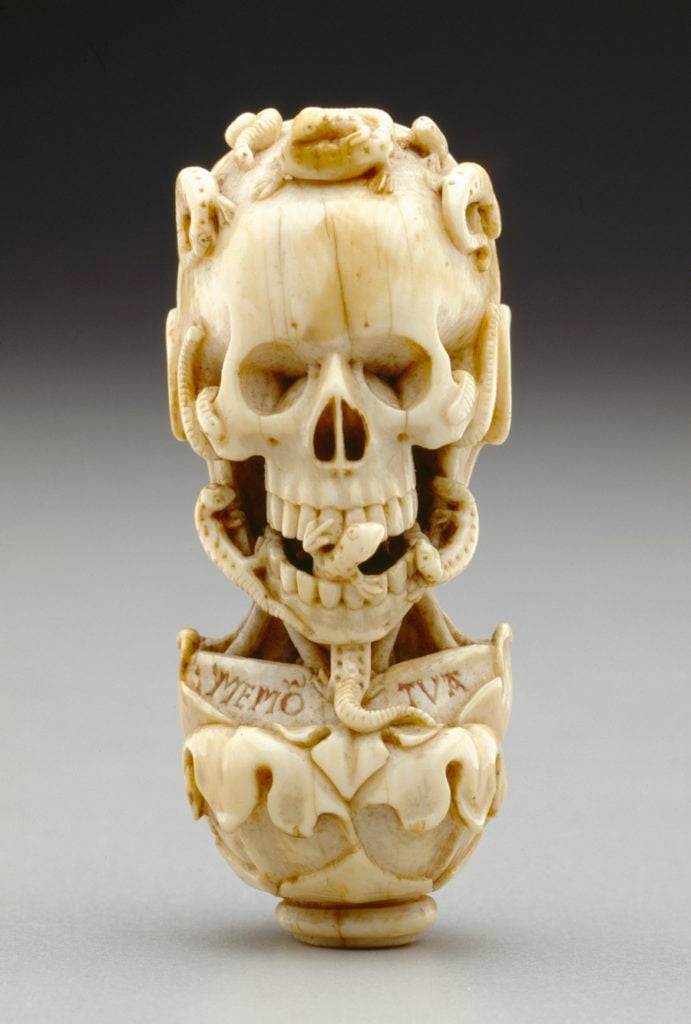
Unknown artist, Memento Mori Prayer Bead (1500–1550). Courtesy of Bowdoin College Museum of Art.
Modern viewers, including Perkinson’s students, can be resistant to images that confront death. “You’ll show them one of these, and they’ll go ‘Ew!’” he says. “They’re looking at all of the worms and the signs of decay.”
Perkinson directs his students to look more closely and to realize that the sculptures encourage “a battle within yourself,” he says. “We live in such an image-saturated culture that it’s hard to get back to the kinds of slow looking that these expect. That initial quick, passing ‘Oh yuck’ is not the kind of looking you’re supposed to do. It really is a matter of holding it and thinking about it.”
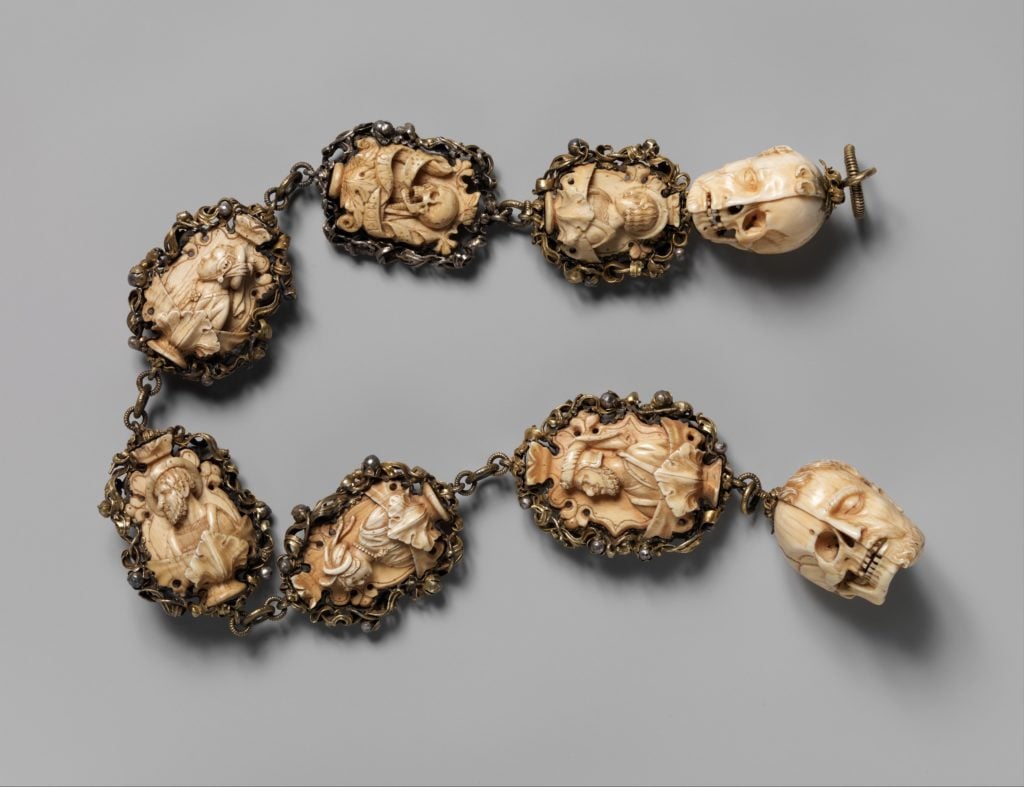
France or southern Netherlands, “Chaplet” (c. 1520–1540). Courtesy of the Metropolitan Museum of Art.
2. Consider Them in the Context of Morality, Not Religion.
Separating morality and religion in the Middle Ages can be a tricky and fraught business, but memento mori ivories—which were overwhelmingly created by artisans and sold directly to wealthy collectors, rather than being commissioned by the church—should be considered through a secular lens.
While the number of intricately carved skulls in a strand of ivory beads might equal the number of prayer beads on a rosary, they are “more about invoking other sorts of moralizing notions of the time that aren’t paraliturgical,” Perkinson says. “They are about good behavior.”
Ironically, however, these objects—which were designed to project the transience of earthly possessions—were also very expensive to produce. “It becomes almost a license to produce and own luxury items,” Perkinson says. (Think of modern equivalents like Burning Man, expensive jeans torn to look just so, or “glamping.”)
It comes as no surprise that these objects would have surfaced around 1500, when ivory was plentiful in Europe for the first time in over a century after trade with Africa had begun opening up in the 1490s.

France or Netherlands, rosary bead (c. 1520–1530). © Victoria and Albert Museum, London 2017.
A memento mori object “challenges you to look closely, because it’s so bloody small,” Perkinson says. Indeed, their size is part of what made the objects so popular: They were a beloved part of collectors’ kunstkammers, or curiosity cabinets, which were all the rage in Europe at the time.
Some of the small skull sculptures in the Bowdoin exhibition feature tiny pinpricks above the eyes and on the cheekbones. At first, Perkinson thought they were meant to pin the works or to hold them up. Then, he learned that they are foramina: anatomical features on the skull that allow for vein and nerve passage. These works were made around the same time that medieval researchers were increasingly dissecting and studying corpses. “They’re putting that level of detail in,” Perkinson says.
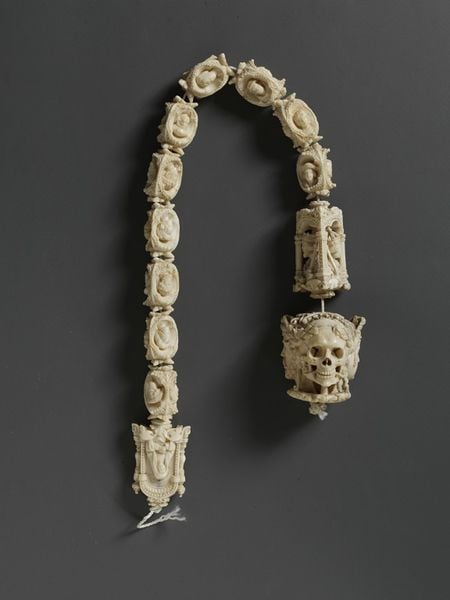
Ivory rosary (c. 1530). © Victoria and Albert Museum, London, 2017.
4. The Objects Are Meant to Be Seen, Not Used.
Ivory rosaries that were hung from a belt or frequently used for prayer usually show signs of wear. “Ivory is soft enough that you can really rub it down, and it absorbs your skin oil and takes on a really beautiful kind of honey-color patina,” Perkinson says, standing in front of an elephant ivory rosary on loan from the Victoria and Albert Museum.
But this delicately carved rosary, which includes a three-sided bead depicting a man, a woman, and a skull, shows little damage. “They look like prayer beads, but they also look like nobody ever prayed [with them],” Perkinson says. He suspects that many memento mori ivories were placed inside curiosity cabinets as part of broader narratives rather than being handled on a regular basis.
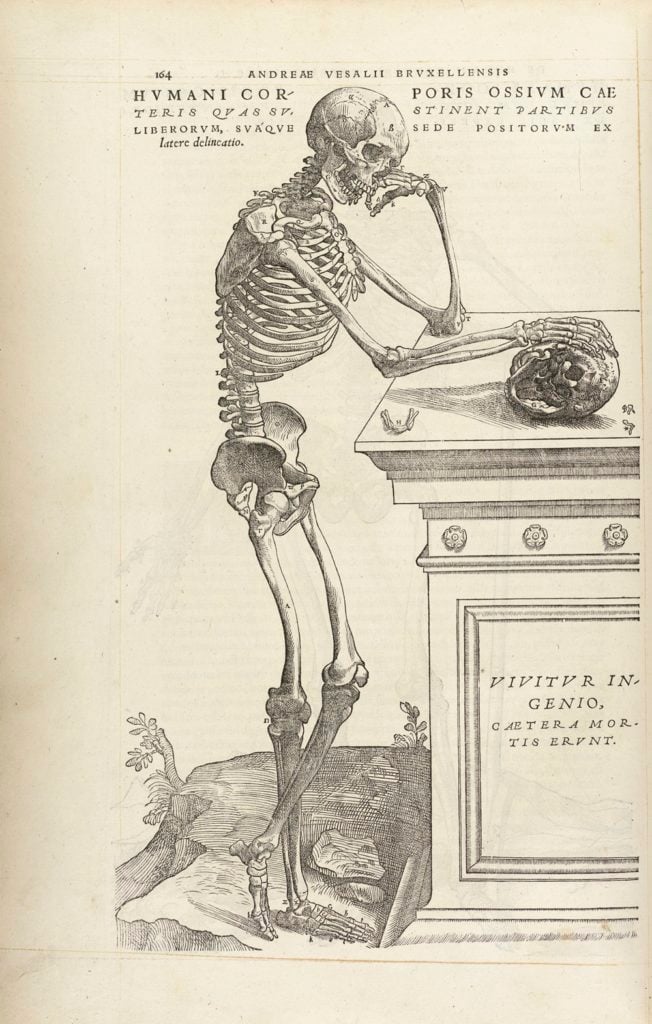
Andreas Vesalius, De humani corporis fabrica libri septem … A Human Skeleton Leaning Against a Tomb (1543). Image courtesy of the Wellcome Library, London.
5. Look Out for Unusual Perspectives.
Although frontal views of skulls are easily rendered, many of the drawings of skulls in memento mori objects adopt a considerably more abstract vantage point: a worm’s-eye view from underneath the jaw.
“They’re totally obsessed with the undersides of skulls,” Perkinson says, pointing to a woodcut illustration from a mid-16th century southern Netherlandish book by Andreas Vesalius. In the etching, a full skeleton rests its right hand upon another skull, which is depicted from underneath.
The perspective reflects artists’ complex attitudes about the body in the mid-16th century. “People are obsessed with the idea that your face conveys something really essential about who you are,” Perkinson says. “At the same time, there’s the counter push, which is that your face goes away, so the skull is the sort of retort to your face.”
The underside of the skull—rendered with complex foreshortening—allows artists to explore the idea that the body is an empty shell after death. “The underside of the skull looks like the surface of the moon,” he says. “It has nothing to do with human appearance in any recognizable way. It’s an abstraction.”
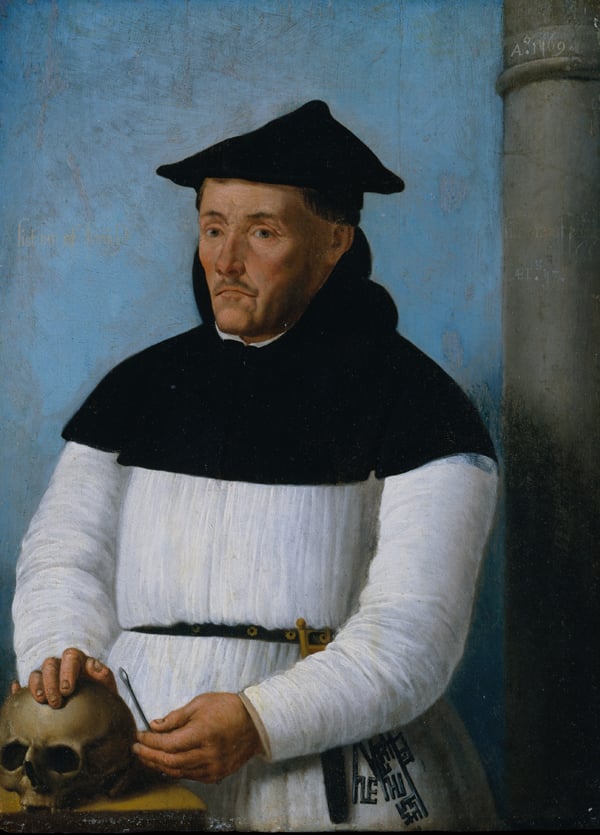
Unknown artist, Portrait of a Surgeon (1569). Courtesy of the Metropolitan Museum of Art and Bowdoin College Museum of Art.
6. Don’t Romanticize Medieval Morbidity.
Don’t read too much into the abundance of skulls in memento mori objects, however. Death was more conspicuous in the medieval world, but viewers should resist the temptation to conclude that medieval and Renaissance society was “obsessed with death because of rampant disease and devastating plague,” says the Metropolitan Museum’s Boehm.
The Bowdoin exhibition argues that memento mori works carry optimistic, carpe-diem messages, and that the impact of the plague in the Middle Ages wasn’t so different from that of modern disease.
“The modern world still wrestles with pandemics, with Spanish flu and AIDS as bookends of the 20th century and Zika at the beginning of the 21st,” Boehm says. “At the end of the day, we can all run marathons and eat kale until the cows come home, but let’s not kid ourselves—none of us is getting out of here alive.”
And even though medieval people living in cities could expect, on average, to live into their 40s, those living in the year 1500 would have thought about how good things were compared to what their grandparents had endured, Perkinson notes.
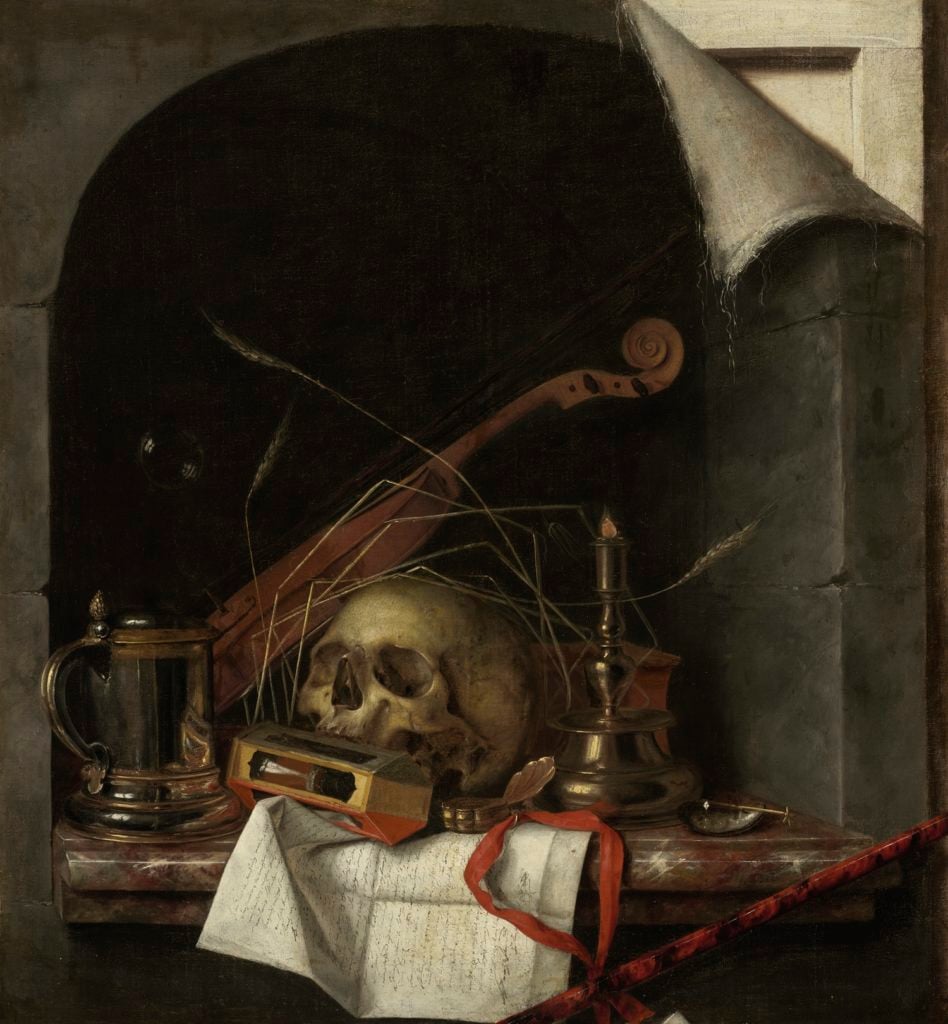
Cornelis Norbertus Gysbrechts, Vanitas Still Life (c. 17th century). Courtesy Wikimedia Commons.
Memento mori objects inspired Dutch artists living more than a century later to create works in a similar genre called vanitas. In vanitas paintings, allusions to inevitable change and decay loom large—but it’s easy for modern viewers to miss them.
Bubbles about to burst, shifting shadows, hourglasses, flickering candles, musical instruments (music, after all, is temporal)—all these images are meant to convey that everything is in flux and beauty cannot endure.
But vanitas symbolism, which is perhaps best known in the works of 17th-century Dutch painter Pieter Claesz, can be so beautifully rendered—each drop or insect’s wing on a grape looks like it could have taken a week to paint—that it’s easy to miss their ominous undertones.
These and traditional memento mori objects sit right on the edge between hopeful and morbid. They are, as Boehm says, “exquisite works of art that speak powerfully about the transitory nature of life.”